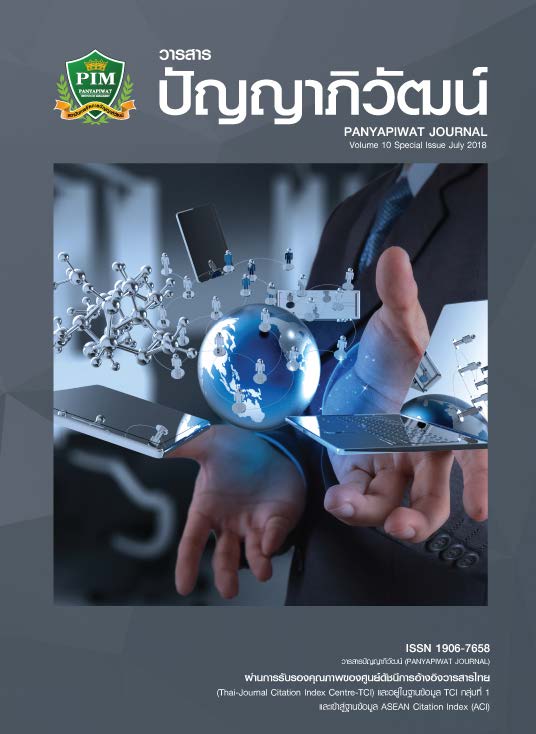อิทธิพลของส่วนประสมการค้าปลีกที่ส่งผลต่อความจงรักภักดีของลูกค้าร้านค้าปลีก ประเภทไฮเปอร์มาร์เก็ตในเขตกรุงเทพมหานคร
Main Article Content
บทคัดย่อ
การวิจัยครั้งนี้มีวัตถุประสงค์เพื่อศึกษาอิทธิพลของส่วนประสมการค้าปลีกที่ส่งผลต่อความจงรักภักดีของลูกค้าร้านค้าปลีกประเภทไฮเปอร์มาร์เก็ตในเขตกรุงเทพมหานคร โดยกลุ่มตัวอย่างที่ใช้ในการศึกษาครั้งนี้คือ ลูกค้าที่เคยใช้บริการและซื้อสินค้าของร้านค้าปลีกประเภทไฮเปอร์มาร์เก็ตในเขตกรุงเทพมหานคร จำนวน 400 คนจาก 6 พื้นที่ของกรุงเทพมหานคร ซึ่งได้มาจากการสุ่มตัวอย่างแบบหลายขั้นตอน และใช้แบบสอบถามเป็นเครื่องมือในการเก็บรวบรวมข้อมูล สถิติที่ใช้ในการวิเคราะห์ข้อมูลคือ ร้อยละ ค่าเฉลี่ย ส่วนเบี่ยงเบนมาตรฐาน ค่าสัมประสิทธิ์สหสัมพันธ์แบบเพียร์สันและการวิเคราะห์การถดถอยพหุคูณแบบนำเข้า
ผลการวิจัยพบว่า ส่วนประสมการค้าปลีกภาพรวมมีความสัมพันธ์กับความจงรักภักดีของลูกค้าที่ระดับนัยสำคัญทางสถิติ 0.01 เมื่อพิจารณารายด้านพบว่า ส่วนประสมการค้าปลีกด้านการบริการลูกค้า ด้านการสื่อสาร ด้านการตั้งราคา ด้านการคัดสรรสินค้า ด้านการตกแต่งร้านและการจัดแสดงสินค้า และด้านทำเลที่ตั้งมีความสัมพันธ์กับความจงรักภักดีของลูกค้าที่ระดับนัยสำคัญทางสถิติ 0.01 นอกจากนี้เมื่อพิจารณาถึงอิทธิพลของส่วนประสมการค้าปลีกที่ส่งผลต่อความจงรักภักดีของลูกค้าพบว่า ส่วนประสมการค้าปลีกด้านการบริการลูกค้า ด้านการสื่อสาร และด้านการตั้งราคามีอิทธิพลต่อความจงรักภักดีของลูกค้าตามลำดับที่ระดับนัยสำคัญทางสถิติ 0.05 โดยสามารถร่วมกันอธิบายความจงรักภักดีของลูกค้าได้ร้อยละ12.3 ในขณะที่ส่วนประสมการค้าปลีกด้านอื่นๆ ได้แก่ การคัดสรรสินค้า การตกแต่งร้านและจัดแสดงสินค้า และทำเลที่ตั้ง ไม่มีอิทธิพลต่อความจงรักภักดีของลูกค้าที่ระดับนัยสำคัญทางสถิติ 0.05
Article Details
“ข้าพเจ้าและผู้เขียนร่วม (ถ้ามี) ขอรับรองว่า บทความที่เสนอมานี้ยังไม่เคยได้รับการตีพิมพ์และไม่ได้อยู่ระหว่างกระบวนการพิจารณาลงตีพิมพ์ในวารสารหรือแหล่งเผยแพร่อื่นใด ข้าพเจ้าและผู้เขียนร่วมยอมรับหลักเกณฑ์การพิจารณาต้นฉบับ ทั้งยินยอมให้กองบรรณาธิการมีสิทธิ์พิจารณาและตรวจแก้ต้นฉบับได้ตามที่เห็นสมควร พร้อมนี้ขอมอบลิขสิทธิ์บทความที่ได้รับการตีพิมพ์ให้แก่สถาบันการจัดการปัญญาภิวัฒน์หากมีการฟ้องร้องเรื่องการละเมิดลิขสิทธิ์เกี่ยวกับภาพ กราฟ ข้อความส่วนใดส่วนหนึ่งและ/หรือข้อคิดเห็นที่ปรากฏในบทความข้าพเจ้าและผู้เขียนร่วมยินยอมรับผิดชอบแต่เพียงฝ่ายเดียว”
เอกสารอ้างอิง
Agarwal, A., Singhal, A. & Goel, B. (2014). A Study of emotional satisfaction, relationship quality & customer loyalty in retail industry. International Journal of Retailing & Rural Business Perspectives, 3(1), 732-740.
Apiprachayasakul, K. (2014). Introduction to retail business. Bangkok: Focus Media. [in Thai]
Berman, B. & Evans, J. (2007). Retail Management: A Strategic Approach (7th ed.). Prentice-Hall International.
Caruana, A. (2002). Service Loyalty: The Effects of Service Quality and the Mediating role of Customer Satisfaction. European Journal of Marketing, 36(7), 811-828.
Field, A. (2009). Discovering statistics using SPSS (3rd ed.). London: SAGE Publications.
Gottlieb, U., Brown, M. & Grennan, J. (2011). The influence of service quality and trade show effectiveness on post-show purchase intention. European Journal of Marketing, 45(11/12), 1642-1659.
Gull, S. & Tariq, R. (2011). Impact of loyalty programs in grocery retailing on loyalty of local customers in Lahore, Pakistan: an empirical study of famous grocery retailers in local market. Interdisciplinary Journal of Contemporary Research in Business, 3(3), 1007-1019.
Hasty, R. & Reardon, J. (1997). Retail Management. New York: The McGraw-Hill Companies.
Inkaew, S. (2010). Retailing Management. Bangkok: Tana Press. [in Thai]
Jacoby, J. & Chestnut, R. (1978). Brand loyalty measurement and management. New York: Wiley.
Kim, K., Kim, Y., Lee, M. & Youn, M. (2014). The effects of co-brand marketing mix strategies on customer satisfaction, trust and loyalty for medium and small traders and manufacturers.E+M Ekonomie a Management, 1, 140-151.
Kurniawan, R. (2012). The influence of retailing mix performance and customer relationship marketing on customer loyalty. ICBME, At Manila, Philippines, 1, 198-204.
Levy, M. & Weitz, B. A. (2009). Retailing management (7th ed.). London: McGraw-Hill.
Lorpraditpong, N. (2006). Customer’s satisfaction surveys manual, with case studies and techniques effective practice. Bangkok: Thailand Productivity Institute. [in Thai]
Mafini, C. & Dhurup, M. (2015). Drivers of customer loyalty in South African retail stores. Journal of Applied Business Research, 31(4), 1295-1310.
Newman, A. & Cullen, P. (2002). Retailing: Environment and Operations. Thompson Learning: London.
Nunnally, J. C. & Bernstein, I. H. (1994). Psychometric theory (3rd ed.). New York: McGraw-Hill.
Oliver, R. L. (1999). Satisfaction: A behavioral perspective on the consumer. Boston MA: Irwin/McGraw-Hill.
Pearce, M. (1997). The True Science of Nurturing Marketing. Marketing Technique, 97(7), 6-8.
Positioning Magazine. (2015). Buying Power Decline, Retailing Business Shock: Growth rate of 2015 only 3.2%. Retrieved December 17, 2015, from https://positioningmag.com/61092 [in Thai]
Siddiqi, K. O. (2011). Interrelations between service quality attributes, customer satisfaction and customer loyalty in the retail banking sector in bangladesh. International Journal of Business and Management, 6(3), 12-36.
Srisaard, B. (2002). Basic Research (7th ed.). Bangkok: Suviriyasan Printing. [in Thai]
Terblanche, N. S. (2017). Customer interaction with controlled retail mix elements and their relationships with customer loyalty in diverse retail environments. Journal of Business and Retail Management Research (JBRMR), 11(2), 1-10.
Tirakanan, S. (2005). Program Evaluation: Best Practice (6th ed.). Bangkok: Chaulalongkorn University Printing. [in Thai]
Vanichbuncha, K. (2012). SPSS for Windows (20th ed.). Bangkok: Dharmasarn Printing. [in Thai]
William, G. Z., Barry, J. B., Jon, C. C. & Mitch, G. (2013). Business Research Methods (9th ed.). United States: McGraw-Hill.


